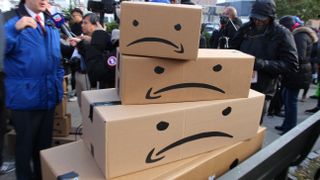Amazon is suing 10,000 people for leaving fake reviews, but is that enough?
The online store still has a fake review problem

If you’ve bought a five-star rated item on Amazon only to have it fall apart within days of getting it, then you’ve likely wondered if any of those reviewers actually used the product. Well, spoiler alert, it turns out that they might not have done, as Amazon is suing over 10,000 people for orchestrating plots to leave thousands of fake reviews on products in its digital stores.
Filed on Monday, the legal action takes aim at Facebook group admins that have accepted cash or other favors in exchange for posting a load of made-up reviews for products sold on Amazon in the US, UK, France, Germany, Italy, Spain, and Japan (via TechCrunch).
This isn’t the first time Amazon has taken such measures against fake reviews on its services – with the 10,000 number reportedly just the amount of groups that Amazon has reported to Facebook since 2020. It’s actually been suing people for bogus reviews since at least 2015.
Beyond legal action, Amazon also tries to deploy a few other tactics to stop fake reviews.
In response to a request for comment, a spokesperson told us that "more than 12,000 Amazon employees around the world" work to keep its stores free from fraud. AI and investigators use various tools and identifiers to analyze and either verify or discard the over 30 million reviews that it receives each week. As a result, as an Amazon blog post from 2021 explained, over 200 million fake reviews were blocked in 2020 before they were even seen by a customer.
Yet despite these successes, some fake reviews are still breaking through, and while Amazon does its part to lay blame at social media platforms like Facebook that facilitate fake review groups, at the end of the day the buck stops with Amazon itself.
Analysis: The best thing they never bought
Considering this isn’t the first time Amazon has had to sue people over fake reviews it feels a lot like its current method clearly isn’t effective. But what else can it do?
Get daily insight, inspiration and deals in your inbox
Get the hottest deals available in your inbox plus news, reviews, opinion, analysis and more from the TechRadar team.
Well, it might be time to change who can review products and scrub out all of the accounts that left a rating but didn’t actually buy the item themselves.
While Amazon does its part to promote “Verified Purchase” reviews when you scroll to the bottom of the page – which highlights reviews from accounts that bought the product at its regular price (or only received a slight discount) – that doesn’t stop bad actors from pumping up the overall review count and spamming 5-star ratings. How often have you actually read the in-depth reviews and not just hit Buy Now on that four-and-a-half-star product with 7,683 ratings?
Instead, it would be much better to only count Verified Purchase reviews and remove any ratings that don’t meet the same standards.
Sure, this method has its faults – chiefly it stops people from leaving a rating if they bought the device from elsewhere – but that seems like a small price to pay to have better peace of mind that the reviews being left are actually genuine. There will undoubtedly be bad actors who find new ways to beat this system too, but it’ll definitely be harder (and more expensive) hopefully limiting how widespread the issue is.
We’ll have to wait and see what actions Amazon takes next if anything, but for something more immediate we’d recommend reading through our guide on how to spot fake Amazon reviews. While we can’t guarantee it’ll keep you completely safe it should limit the chances you’re tricked by a phony review.

Hamish is a Senior Staff Writer for TechRadar and you’ll see his name appearing on articles across nearly every topic on the site from smart home deals to speaker reviews to graphics card news and everything in between. He uses his broad range of knowledge to help explain the latest gadgets and if they’re a must-buy or a fad fueled by hype. Though his specialty is writing about everything going on in the world of virtual reality and augmented reality.
